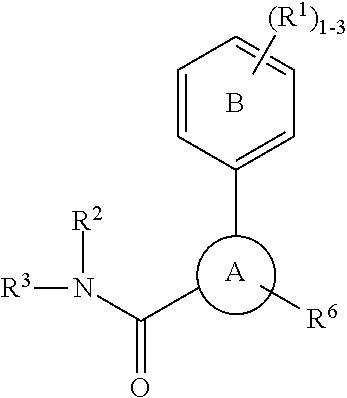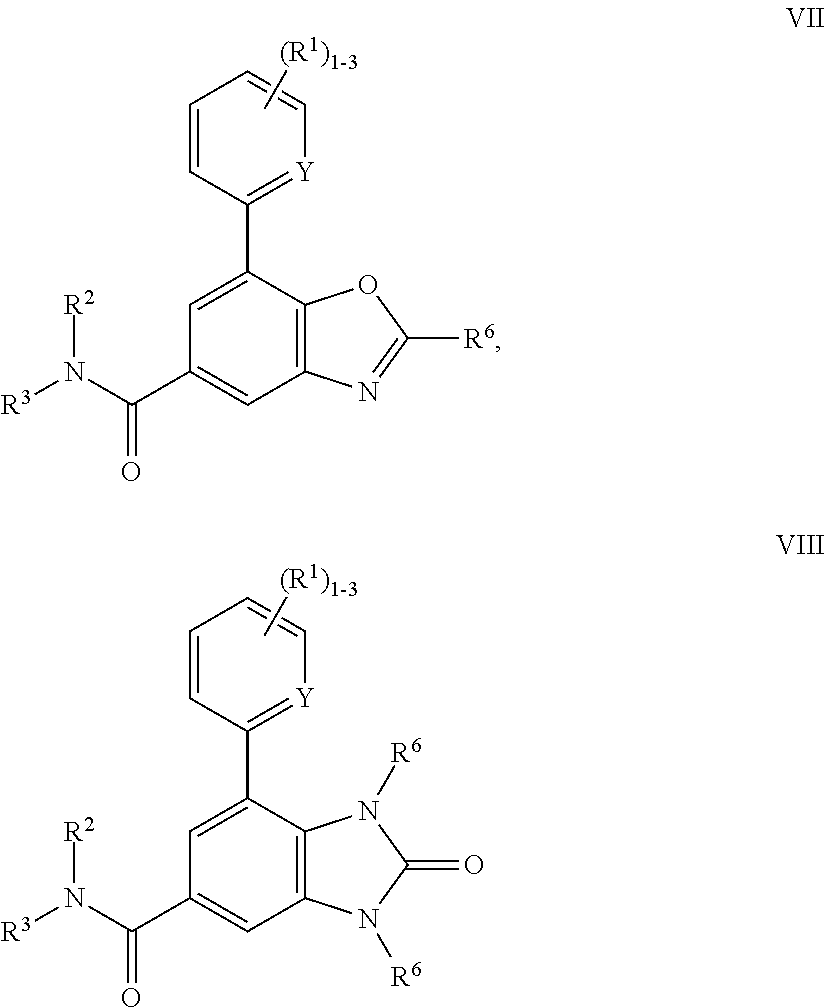P2X3 Receptor Antagonists for Treatment of Pain
a p2x3 receptor and antagonist technology, applied in the field of compounds, can solve the problems of complex utility of purinergic ligands available to evaluate the role of individual p2 receptor subtypes in mammalian physiology, intense pain, and pronounced increase in sensory nerve discharg
- Summary
- Abstract
- Description
- Claims
- Application Information
AI Technical Summary
Benefits of technology
Problems solved by technology
Method used
Image
Examples
example 1.1
[0132]
N-[(1R)-1-(5-Fluoropyridin-2-yl)ethyl]-8-(4-methylphenyl)imidazo[1,2-a]pyridine-6-carboxamide
Step A: ethyl 8-bromoimidazo[1,2-a]pyridine-6-carboxylate
[0133]To a solution of ethyl 6-amino-5-bromonicotinate (5.0 g, 20.4 mmol) in N,N-dimethylformamide (204 mL) were added bromoacetaldehyde dimethylacetal (3.45 g, 20.4 mmol) and p-toluenesulfonic acid (0.53 g, 3.1 mmol). The mixture was heated to 90° C. After 18 h, additional bromoacetaldehyde dimethylacetal (3.45 g, 20.4 mmol) and 4A° molecular sieves were added. The mixture was stirred at 90° C. for another 24 h. The mixture was warmed to ambient temperature and aqueous LiCl (3.0 M) was added. The mixture was extracted with ethyl acetate (3×). The combined organic layer was washed with brine, dried over sodium sulfate, filtered and concentrated. There was still some DMF in the crude product. Water was added and the mixture was extracted with t-butyl methyl ether, washed with brine, dried over sodium sulfate, filtered and concentr...
example 2.1
[0136]
N-[(1R)-1-(5-Fluoropyridin-2-yl)ethyl]-5-(4-methylphenyl)imidazo[1,2-a]pyridine-7-carboxamide
Step A: 2-(benzylamino)-6-(4-methylphenyl)isonicotinic acid
[0137]To a solution of 2-(benzylamino)-6-chloroisonicotinic acid (0.9 g, 3.43 mmol) in THF (8.57 mL) and water (8.57 mL) were added (4-methylphenyl)boronic acid (0.70 g, 5.14 mmol), dichloro[1,1′-bis(diphenylphosphino)ferrocene]palladium(II) dichloromethane adduct (0.14 g, 0.17 mmol) and cesium carbonate (3.35 g, 10.3 mmol). The mixture was purged with nitrogen and was heated to 120° C. in the microwave reactor for 7 min. The mixture was filtered with Celite and saturated aqueous sodium bicarbonate was added. The mixture was extracted with ethyl acetate (3×). The combined organic layer was washed with brine, dried over sodium sulfate, filtered and concentrated. Purification by silica gel chromatography (100% dichloromethane→80% dichloromethane / methanol) gave the title compound (0.63 g): LC-MS [M+1]=318.9.
Step B: tert-butyl 2-(b...
example 3.1
[0143]
N-[(1R)-1-(5-Fluoropyridin-2-yl)ethyl]-8-(4-methylphenyl)[1,2,4]triazolo[4,3-a]pyridine-6-carboxamide
Step A: tert-butyl 5-chloro-6-hydrazinonicotinate
[0144]To a solution of tert-butyl 5,6-dichloronicotinate (2.0 g, 8.1 mmol)) in ethanol (40.3 mL) was added hydrazine hydrate (1.18 mL, 24.2 mmol). The mixture was heated 75° C. After 18 h, the mixture was cooled to ambient temperature. The mixture was concentrated to dryness: LC-MS [M+1]=244.1.
Step B: tert-butyl 8-chloro[1,2,4]triazolo[4,3-a]pyridine-6-carboxylate
[0145]Trimethyl orthoformate (19 mL, 172 mmol) was added neat to tert-butyl 5-chloro-6-hydrazinonicotinate (1.9 g, 7.8 mmol). The mixture was heated to 85° C. After 4 h, the mixture was cooled to ambient temperature and concentrated to dryness: LC-MS [M+1]=254.1.
Step C: tert-butyl 8-(4-methylphenyl)[1,2,4]triazolo[4,3-a]pyridine-6-carboxylate
[0146]To a solution of tert-butyl 8-chloro[1,2,4]triazolo[4,3-a]pyridine-6-carboxylate (1.7 g, 6.7 mmol) in n-propanol (53.6 mL) an...
PUM
| Property | Measurement | Unit |
|---|---|---|
| Fraction | aaaaa | aaaaa |
| Electrical conductance | aaaaa | aaaaa |
| Electrical conductance | aaaaa | aaaaa |
Abstract
Description
Claims
Application Information
 Login to View More
Login to View More - R&D
- Intellectual Property
- Life Sciences
- Materials
- Tech Scout
- Unparalleled Data Quality
- Higher Quality Content
- 60% Fewer Hallucinations
Browse by: Latest US Patents, China's latest patents, Technical Efficacy Thesaurus, Application Domain, Technology Topic, Popular Technical Reports.
© 2025 PatSnap. All rights reserved.Legal|Privacy policy|Modern Slavery Act Transparency Statement|Sitemap|About US| Contact US: help@patsnap.com



